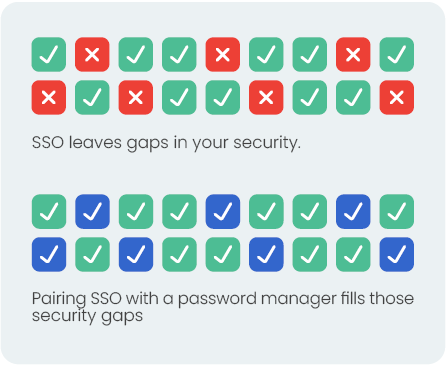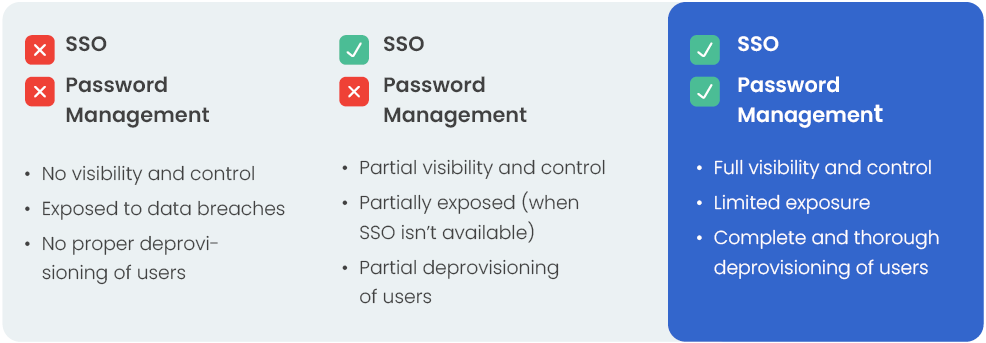The digital transformation has driven fundamental changes across practically all industries. Cloud computing, artificial intelligence, and digitising analogue information into digital form have all taken slightly different paths. There is, however, one thing all organizations have in common: They need to accompany this increased prevalence of digital tools with robust access management systems.

A popular solution that offers considerable advantages in terms of security is Single Sign-On or SSO. In fact, did you know that the SSO market is estimated to reach a size of US$8.4 Billion by 2030?
SSO can help you safeguard your sensitive data and strengthen your authentication strategy – but it also has risks and vulnerabilities that need to be considered as well.
In this article, we will explain why, although SSO has considerable advantages, it should not be the exclusive strategy for managing your company’s digital access and security. Let’s dive in.
The Benefits of Single Sign-On (SSO)
We should start with a definition. What is Single Sign-On, and why is its impact relevant to businesses?

Single Sign-On allows users to access multiple applications and services using just one set of login credentials. In other words, instead of remembering various usernames and passwords for your applications, you can just use the same ones.
This is possible because you have a central system that is responsible for authenticating users and verifying their identity. Once the host confirms the person is who they say they are, it gives them access to the requested resources. The user just logs in once, and the SSO service provider allows them to use the various SP-hosted applications seamlessly.
Single Sign-On is commonly used in business contexts to:
- Improve employee productivity: We know that the average person needs to remember about 100 passwords. So, employees who need to use several software applications and tools to perform their tasks can save time by reducing the need to remember multiple passwords (something that also leads to password fatigue).
- Simplify access to enterprise applications and cloud services: Many businesses use enterprise-level applications (many of which are also available in the cloud), such as customer relationship management (CRM) systems, accounting software, and project management tools. SSO simplifies access to these applications.
- Provide better mobile and remote access: SSO simplifies the login process and ensures secure access to business applications from various locations and devices, something particularly valuable for employees who work remotely or use mobile devices.
- Enhance security: Your organization can combine SSO with other security measures (like Two-Factor Authentication or 2FA, User Behavior Analytics or UBA, Identity and Access Management or IAM, and Single Logout) to protect its sensitive business data from unauthorized access and cyber threats.
Why SSO is Not Enough
Although Single Sign-On can offer your company numerous benefits (especially in terms of simplifying user authentication), this technology also involves significant limitations and potential risks. So, let’s see the pros and cons of SSO and why they matter.
The first limitation of SSO is that, just like this technology acts as a single point of access, it also can become a single point of failure. For example, if your SSO provider experiences an outage or security breach, it could lock users out of all integrated systems and disrupt your business operations.
Another thing to remember when considering the limitations of SSO is that implementing SSO can sometimes lead to a more complex user experience – particularly during the initial setup and configuration steps.
On the one hand, your IT team will have to ensure they can set up and integrate SSO across various applications (something that can require coordination with their vendors). On the other hand, users will have to learn to manage their authentication settings.
The last of the Single Sign-On disadvantages you should consider is that implementing SSO may introduce additional compliance and audit considerations, especially in industries with particularly stringent requirements. So, ensuring that your chosen SSO solution meets industry-specific security standards is vital.
| Advantages | Disadvantages |
|---|---|
| Improved user experience | Single point of failure |
| Reduced password fatigue | Can be complex to implement and manage |
| It can be complex to implement and manage | Can be expensive |
| Reduced help desk tickets | Not all applications support SSO |
| Improved IT efficiency | Can introduce new security risks |
The Misunderstood Role of Business Password Managers
There are legitimate concerns and arguments against business password managers, such as fears about storing all passwords in one place, cost-related concerns when SSO is in place, and perceptions of a complicated user experience.
1- Fear of Storing All Passwords in One Place
A common concern is that passwords are stored in one centralized location (a rather tempting target for hackers) by using a password manager. So, if the password manager is compromised, there could be a catastrophic data breach.
While this fear is valid, reputable business password managers employ robust encryption and security measures to protect stored passwords and adhere to industry best practices to safeguard user data. And they are often safer than using weak, easily guessable passwords or reusing passwords across multiple accounts.

2- Cost Concerns
Some businesses argue that investing in a password manager is redundant and costly if they already have a Single Sign-On.
However, it’s important to remember that SSO and password managers serve different purposes. While SSO simplifies authentication by allowing users to sign in once and access multiple applications, it doesn’t necessarily manage individual passwords within those applications. So, a password manager complements SSO by securely storing and generating strong, unique passwords for each application.
3- Perceptions of the Complicated User Experience
Some employees may be concerned that using a password manager will introduce complexity and disrupt their workflow.
Now, while there may be an initial learning curve, modern password managers are designed with user-friendliness in mind. As a result, they often come with browser extensions and mobile apps that seamlessly integrate into the user’s workflow, making password management convenient and efficient. Plus, many password managers also offer features like auto-fill and auto-login.
How Business Password Managers Complement SSO
If you want to enhance your company’s overall cybersecurity, one of the best things you can do is integrate a Single Sign-On solution to help you manage your user passwords, generate Two-Factor Authentication credentials, and diversify your security strategy.

SSO authentication and business password managers are a great pairing because:
- SSO simplifies user access by allowing employees to sign in once and access multiple applications seamlessly. A password manager complements SSO by securely storing and organizing all credentials in one centralized location.
- Password managers allow you to generate complex, randomized passwords that are difficult to guess or crack. And the best part is: Users don’t need to remember each of them!
- For an extra layer of security, you can integrate your password manager with a two-factor authentication (or 2FA) solution. In 2FA, users must provide additional verification, such as a one-time code sent to their mobile device and their password. But did you know that, unfortunately, according to studies, only 35% of people use 2FA (Two-Factor Authentication) or MFA?
- Password managers also promote better password habits among employees as they don’t need to remember multiple complex passwords and are less likely to use weak or repeated ones.
- Relying solely on a single provider for all aspects of cybersecurity, including your SSO implementation, may create a single point of failure. Integrating a password manager with SSO can enable your business to diversify its security strategy and remain operational even if one identity provider experiences an outage or security breach.
- Managers are typically independent solutions, so you can integrate them with various SSO solutions and providers and pick the one that aligns with your specific security requirements and budget.
The Integration of SSO and Business Password Managers
Single Sign-On (SSO) and password managers can work together to give your organization a more comprehensive and robust security strategy. Let’s see some examples to understand exactly how these tools interact with and complement each other, shall we?
Imagine a large enterprise where employees need to access various applications and services. If you have SSO in place, users can log in to their computers or the company’s portal using their centralized credentials and, once authenticated, gain access to multiple applications without needing to enter separate login credentials for each one. This streamlines the login process and saves time, enhancing employee productivity.
Employees may also need to access various applications within the same organisation, some of which may not be SSO-compatible. Here’s where a password manager comes into play. The program securely stores all credentials and generates strong, unique passwords for each application. So, if, for instance, someone needs to access your company’s legacy accounting software (not compatible with SSO), your password manager can automatically generate a secure password for it and store it securely for future use.

As we mentioned above, combining an SSO authentication system and a password manager can also help you add an extra layer of security by supporting 2FA (which uses tokens to give users access).
Conclusion
Did you know that about 80% of financial service businesses have suffered a breach related to authentication system weaknesses?
While SSO simplifies authentication and reduces the need for multiple credentials, password managers can ensure secure storage, generation, and management of strong passwords.
As we have seen in this article, Single Sign-On remains a valuable authentication solution, but you should always be careful to evaluate your business’ needs and consider combining it with more robust security measures and continuous monitoring.
In light of these arguments, you should reconsider your digital access strategies. Reach out to Uniqkey today and let us show you how the combination of these tools can enhance your business’ security, improve the user experience, and help you establish a proactive approach to safeguarding your company’s sensitive data and resources from cyber threats.


